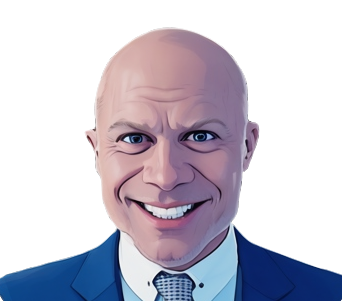Transcript
This episode is brought to you by Equilibria, Inc. Equilibria provides training to assist fast-growing companies in documenting and improving their key processes for maximum operational performance. Visit EQBsystems.com to learn more. That’s EQBsystems.com.
Years ago, I remember a consultant telling me that, “It’s impossible to scale a servicebased business.” “Impossible?” I wondered aloud. “Yeah, impossible,” the consultant confidently repeated. “Really?” I asked, “Well how do you explain the Big 4? You know, McKinsey, PWC…those are global consulting firms.” That consultant was silent for a bit and then said that they were exceptions and not the rule. But are they really?
This is Scale Tales, a business storytelling podcast where people share moments when they achieved scale that seemed…impossible. I’m Alicia Butler Pierre and I must admit – there’s no greater satisfaction than proving naysayers wrong! Service-based businesses can’t scale, huh? Well, you’re about to hear from someone who’s actively dispelling that myth.
Jeremy Streten is known by many titles – author, lawyer, serial entrepreneur. But perhaps one of his proudest is his role as Managing Director at Business Legal Lifecycle, a business he started back in 2015 in a quest to find joy at work that he could also scale – one that didn’t rely on his daily presence…and he pulled it off!
This is Ep. 3 – How Jeremy Streten Expanded His Law Business Across Three Countries
My name is Jeremy Streten. I’m a lawyer from Brisbane, Australia. It’s on the east coast of Australia and it will be famous because we have the Olympics in 2032.
Yes, Jeremy is a lawyer but that almost didn’t happen. When I first read about his background, I noticed he went to Queensland University of Technology. Naturally, I was intrigued. How did he switch from I.T. to law?
When I left school, law wasn’t even on my mind, I knew enough about technology to be dangerous and everyone thought that I could do it. So do information technology, you learn about programming and, and things like that. So, yeah, because everyone told me I should do that. I did that and I hated it and I just couldn’t stand it. So it took me a few years to find law. Law in Australia is an undergraduate degree.
I started law because, well, I was really trying to find out what I wanted to do. I did a little bit of politics for six months, but then I decided to do a few little setbacks and I loved it. I loved, solving problems. I loved how it taught me how to learn as well and learn how to, to study and learn how to research. And that was just a natural fit for me. That was the journey.
Thankfully it didn’t take Jeremy long to find a career he could be passionate about. It was official. He was on track to become a lawyer. Now he needed hands-on experience.
So I started working six months before I finished my university degree. There was a concept called your articles of clerkship. I’m not sure whether that happens in the U.S. but essentially it’s a two-year post your undergraduate degree traineeship where you basically do all the jobs that no one else wants to do. And you’ll learn the basic way that a little thing works and all the grunt work around drafting documents. And so I actually changed my degree to part-time so that I could work full time because doing both at the same time was very, very difficult. It’s funny though, that by actually going in and working as an article clerk training to be a lawyer, I got my best marks that I ever did in university in those last 12 months, because I was actually in there applying what I learned.
So I did this articles of collection for two years. And then I became a lawyer. So that was in 2003 that I started that.
And by 2005, Jeremy was a bona fide lawyer. His next job landed him in a small law firm where sharpened his saw in different branches of law; doing the work that, frankly, the partners in the firm didn’t want to do. That turned out to be a blessing in disguise.
I was really a Jack of all trades, as it were in that, it was all sorts of different balls that I did. And I learned a lot in that time. I’m forever grateful to those guys. They taught me so much, it was hard work. But, I learned a lot.
He worked there for another six years. Over time, his enthusiasm for a particular branch of law emerged – business law – and so did a burning desire to start a business.
It just got to the stage where I didn’t want to be there long-term they were going to make me partner. They were going to bring me into the ownership structure of the business. But to be honest, that’s not what I wanted. I didn’t want to be a partner of that law. I do like my old bosses, like they’re great guys, but the other people in the business weren’t really, values aligned with me. And I didn’t feel like I wanted to proceed down that path.
Jeremy found a kindred spirit in Craig Mason, someone he worked with at this law firm. Together, they hatched a plan.
We decided that we would go off and do our own thing. And of course at the time we knew that we could run a better law firm, I say that very sarcastically because we thought we did. And we learned very early on that we didn’t know that.
We great technicians. We can do the work we can get in there and, you know, really help clients with their legal problems. We had no idea how to run a business.
Having that kind of introspection led Jeremy and Craig to hire a business coach to help them understand how to work on and not in their new business. One of the first things they learned was the importance of networking.
And so, we set about building out relationships. we went to, a place that was 50 kilometers, which is probably about 30 miles away from where our old office was. And we sat up there and I really built up a client base around a new network and, really, bringing our expertise to a different area, which was received really well.
Another thing their business coach suggested involved writing a book – an idea that Jeremy thought was absurd.
I said, “Who’s going to read a book written by a lawyer, the boring textbooks?” And he just smiled at me.
He smiled because, as if looking through a crystal ball, this business coach knew a book could help propel Jeremy and Craig’s law firm to new heights. Coincidentally, they also happened to be learning about business lifecycles as part of their training with this coach. And that’s when Jeremy had an epiphany…
I had two matters. One where one client lost over a million dollars, other people’s money. And another one where another client almost lost over $2 million of his own proposal, his own money, all because they didn’t take a proactive approach to their business and applying the law to their business. And I was really frustrated because I’d sit down with, these people who came to see me after the fact. And I said, why didn’t you get legal advice earlier? This is so simple to have solved a year, two years, three, four years ago, if you just got legal advice.
And I got the same excuses that I heard all my business life…”Lawyers are expensive!” They charge in six-minute increments and every time I pick up the phone, I’m on the clock. they speak in big words and they’ve kind of lauded over people to say that they’re smarter or that the implication is that they’re smarter. And they’re just not business minded. They are more minded to solving problems after they’ve occurred. And it really frustrated me, Alicia, it really got to me that here was an industry, which I love working in. Here’s an industry that is designed to help people that is designed to stop people’s businesses from failing.
But we don’t do that. We take a reactive approach where people come to us when they have a problem and we solve that problem. And then they could save all that money early on if they just took a proactive approach.
Okay, so here’s where that business lifecycle work Jeremy started doing with his business coach comes into play.
So in my frustration, I sat down, I still remember the day I sat down, I was in my desk and I was looking at the lifecycle work that we’d done what we’d been studying, the DCE life cycles. And I said, there’s gotta be a way that we can map out the legal journey for a business. So I drew up a lifecycle and I went through and studied at the time we adapted for about 5,000 businesses.
I went through and I asked myself the question. When did they do things that did well? When did I do things that were done poorly? And I mapped out the lifecycle and I went back a few reiterations talking with Craig, my business partner at the time. And he came back with some suggestions and then the business legal lifecycle was born.
This business legal lifecycle had 13 phases. And then it occurred to Jeremy that he now also had the foundation for a book.
I worked out that I had 13 chapters of a book. So I rang my business coach and I said, “Guess what? You were right! I now have a book idea.” And he just laughed and said, “Good now going to run it.” So that’s how the business lifecycle was born.
And so was the book – which took him more time to write, develop and flesh out his ideas. It’s called The Business Legal Lifecycle Book: How to Successfully Navigate Your Way from Start Up to Success and eventually he developed special editions by country – for example there’s an Australian edition, UK, and U.S. – for each edition, he partners with lawyers in those specific countries to ensure the validity of the information.
The book was originally designed as a fancy business card for the law firm. It was after that, that we then developed a quiz, a test that people would take to identify their legal risks.
This quiz was the missing link in the middle of a sales funnel that began with promoting the book and ended with providing legal consultations. The year was 2015 and it became clear that this funnel would be for a separate business. Speaking engagements put Jeremy in front of potential clients and the answers to their quizzes helped him to identify risks, gaps, and other legal shortcomings.
So rather than going to a lawyer, spending thousands of dollars on figuring out what your legal risks are and all the rest of it, we had a quiz that we developed where people could for less than a hundred dollars work out what their legal risk were, and we could help solve them for that. And then we realized if we can do that, other lawyers can do that too. And this is where the businesses formed.
And this was Jeremy’s ticket to scaling – this business model could be replicated over and over with minimal inputs but the possibility of many outputs.
And we, so we started marketing to other lawyers that they started using it. we knew we had a business that we could start to promote and help other lawyers, around Australia. And then I realized, why stay with Australia? Let’s go worldwide. And that’s kind of where we get into today, where we expand internationally, with the lifecycle.
What Jeremy is describing is business infrastructure – a system for linking the people, processes, and tools necessary to scale in a sustainable, profitable and repeatable way. And he succeeded in not only building it but scaling it to multiple countries with a predominantly remote team. So it begs the question – how was he able to scale a law business when the law itself differs around the world? He’ll answer that question after the break.
Some small businesses fail not from the lack of customers, but from too many. When your business receives positive publicity, it’s exciting! The spotlight attracts more customers and the cash flows in. But too much growth too soon can be catastrophic especially if your organization lacks the business infrastructure to support this growth.
Behind the Façade: How to Structure Company Operations for Sustainable Success is a book that introduces a proven framework for building business infrastructure. The book is structured into six relatable stories of entrepreneurs who apply this framework, giving you an inside look at how they solve their fast growth issues and how you can too! Pick up your copy today at BehindtheFacadeBook.com. BehindtheFacadeBook.com.
Before the break you heard the story of Jeremy Streten, a lawyer turned author and entrepreneur who figured out how to scale a service in the legal industry. How? Let him tell it. Here’s Jeremy…
The target countries are really Australia, the U S and the UK, that’s where we’ve built the test. It works in all those countries. It must’ve been 2017 or so I went to a conference in London with my wife, and it was a law conference. And I went in and I was listening to this, very fascinating inverted commas topic about insolvency law, that she was presenting a paper at. And there were lawyers from Russia, from America, from all over the world, all over Africa. And what I realized was that, yes, the law is very specific in different countries and different states. You know, how we do things in Australia and Queensland is different to how they do them in New South Wales is different to how I do it in Georgia.
It’s different all over the place, but the actual high-level concept around the business and the law, and what you need to do is actually the same. And so what I realized was that we could make the book and the quiz universal, because the legal steps people need to take at a high level are all there. The test we provided, it’s 30 questions. It takes about 10 minutes. if you created it any longer than that, people just wouldn’t take it.
Keeping the quiz short also ensures that people get value without overwhelm. Keeping the questions at a high level gives other lawyers in Jeremy’s global network the opportunity to answer specific, clarifying questions. And this is how he achieves scale.
But at the end of the day, the way that this works is that it empowers you as the business owner to know what you need to do, why you need to do it. So then you can go to your lawyer and make sure that you’re protecting your business and plugging those legal risks.
Scaling was always in the back of my mind, big and scaling worldwide, because it’s not a high price product. It is one where different people can do it and use it in different countries, in different areas. I didn’t want to just have the little firm. I wanted to do something on a larger scale.
So what’s the formula for getting people into Jeremy’s scalable sales funnel? It starts with speaking engagements where he talks about his book.
The way that it worked at the end of my talk, where I would basically offer people to take the test, find their legal problems, and then have a consultation with me to go through the work that we really need to do from a legal perspective. And then generally they would engage us as a law firm to do that work. I don’t really do that anymore because that’s not scalable, but I was just proving out the business model at the time.
Once he proved the model worked, instead of Jeremy doing the consultations, he began delegating them to others – you know, that global network of lawyers mentioned earlier.
I would, figure out everything that needs to be done. And then I would have, some junior lawyers to do the legal work, so that I could spend the time going out there and getting more work. It was just a realization that I couldn’t do everything at once. And I’m very lucky that I have a business partner in the law firm, who wanted to run the law firm.
I would slowly delegate more and more work to the team so that it freed me up to do the work that I enjoy. The process that I’ve kind of refined is you keep a record of everything you do for two weeks. At the end of that, two weeks, you work out what’s strategic work and what’s tactical work, and then you highlight in green. So I do it in an Excel spreadsheet or highlight in green things that give me energy and give me joy. And I put in red things that take my energy, that don’t give me joy. I then delegate the red and tactical work and then the red and strategic work. And then the stuff I do in green that, that gives me joy. I continue to doing and then generate a default already. So that’s the person that I do now. It certainly wasn’t what I did five years ago. but that’s, that’s kind of the evolution of the process to help me work my way out of the law firm and make sure that I’m doing stuff that I enjoy.
Jeremy stores this Excel spreadsheet with color-coded work on Dropbox. His trusty business manager then uses a physical Kanban board to divvy out the work marked for delegation across a remote team spread across the U.S., Philippines, and Australia. You might be wondering how their team uses physical Kanban boards in a remote team setting. Well, they each create their own individual boards to keep themselves on track and use Slack to communicate updates. But their software team does something different…
They actually use ClickUp. They use that, but I’m not involved in that side. I have a business partner who’s based in the U.S. and he uses that with the development and software development team.
Although the Business Legal Lifecycle’s funnel begins with Jeremy, this delegation process has enabled his company to triple their volume. It’s also freed up his time significantly. He’s crystal clear that he’s only going to do work that brings him joy so that means scaling on his own terms.
You know, a lot of people said to me, “You’re generating all this work around the world. You could build an international law firm.” And I just don’t want that. The idea of that kind of breaks my brain. I know people who are doing that, and it’s just not something where I want to invest my time. We’ve consciously made the decision to scale that back so that I can spend the time doing this stuff and, and Craig, my business partner, he goes out and gets the work that he wants to do and does all that type of work.
Yeah. One of the things that we’ve introduced to go international, we’ve introduced a lawyer referral program as well, where we actually have people don’t have a lawyer then that can actually ask us to recommend them a lawyer as well.
Most attorneys I know are well read and Jeremy’s no exception. He’s a self-proclaimed avid reader – dedicating at least three hours a day to reading. As our time together came to a close, I could tell he’s invested a lot in his personal development. I mentioned a book by Seth Godin called The Dip – it came to mind when I first saw his business legal lifecycle chart on his company’s website. He also recommended the classic, The E-Myth and another book called The Motive by Patrick Lencioni. As for parting words of advice, he offered two things…
One is, don’t just be reactive to problems in your business, whether they be legal or business problems. If you start to feel yourself in discomfort, lean into that problem and figure out how you’re going to solve it. Because every time you feel discomfort, every time you feel those butterflies in your stomach, that’s an opportunity for you to grow.
So make sure that you’re always growing and that you’re learning from things that aren’t going well. And the other thing is make sure that all your legal decisions are founded on, where you want to take your business. Where do you want to be personally in five years, 10 years, 20 years.. If you had told
me back when I started my law firm 10 years ago, that I’d be recording podcasts and going around the world and doing all this stuff, I would have laughed at you. But if you don’t have some idea about where you’re going, you’re just going to fall into those legal traps that so many people do.
We definitely don’t want you falling into any avoidable legal traps. That’s why we’re so adamant about sharing resources with you, starting with this recap of important lessons learned during this episode. Heed these lessons especially if you offer a service that you’d like to scale.
- Be proactive in seeking legal counsel based on your growth goals.
- Write a book. It’s a great way to demonstrate your expertise.
- Do public speaking to promote your book.
- Develop a quiz to engage people and get them into your sales funnel.
- Share your tools with other experts in your industry to build your network of trusted advisors. You can even collect a referral fee from them.
- Figure out the standard process for delivering your service and then customize it based on your customer’s location.
- Delegate things that rob you of your energy so that you can ultimately work on and not just in your business.
A special thank you to Jeremy Streten for sharing his scale tale with us! You can find links to his company, book, lifecycle quiz, podcast, and other recommended resources at ScaleTalesPodcast.com. Again, that’s ScaleTalesPodcast.com.
Thank you for listening! If you learned something valuable from this episode, please leave us a five-star rating and review wherever you’re listening.
I’m Alicia Butler Pierre and I wrote, produced and narrated this episode. Music production and original score by Sabor! Music Enterprises. Video editing by Gladiola Films. Show notes by Erika Ve Revilla.
You’ve been listening to Scale Tales.






